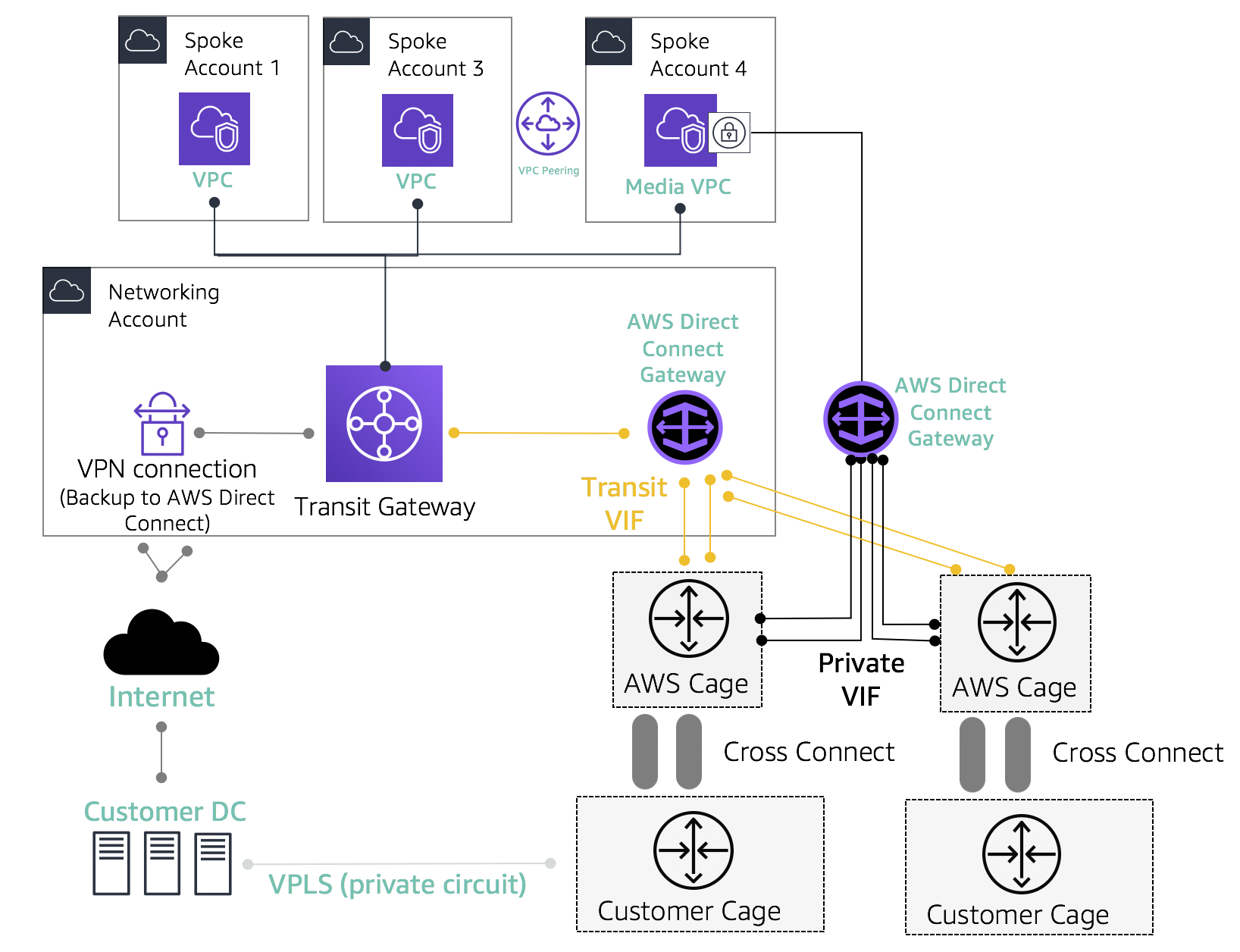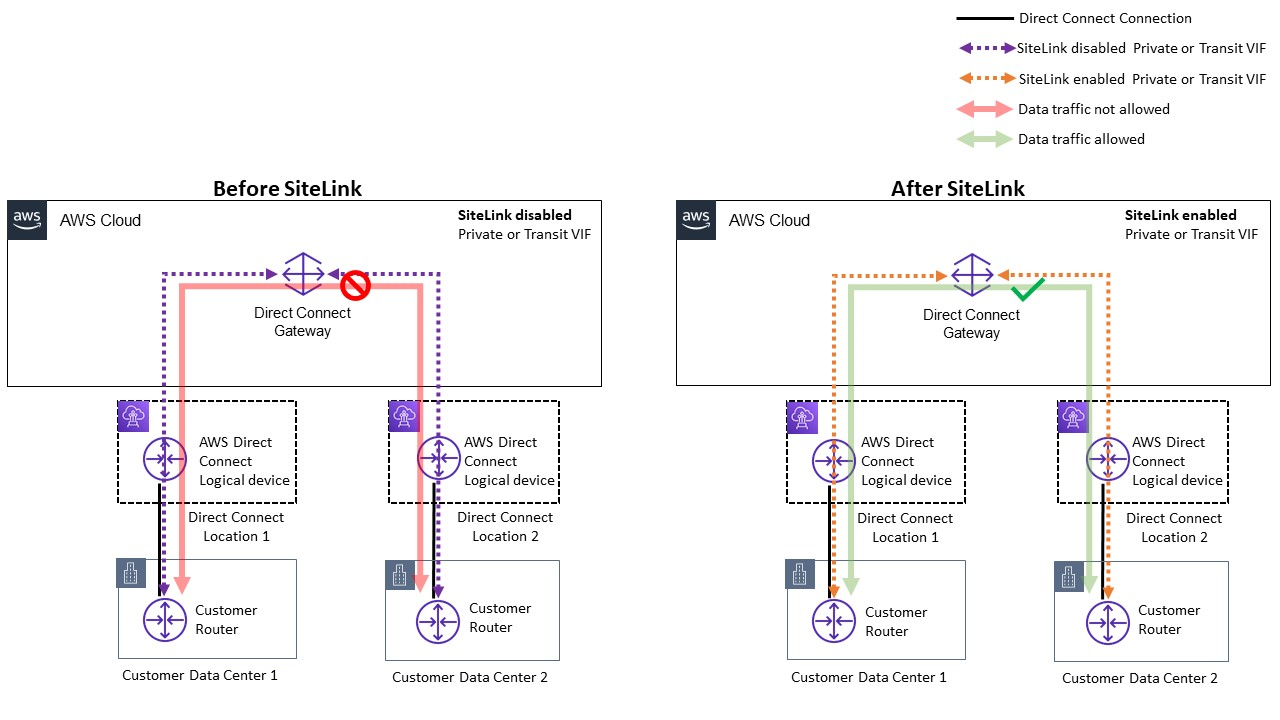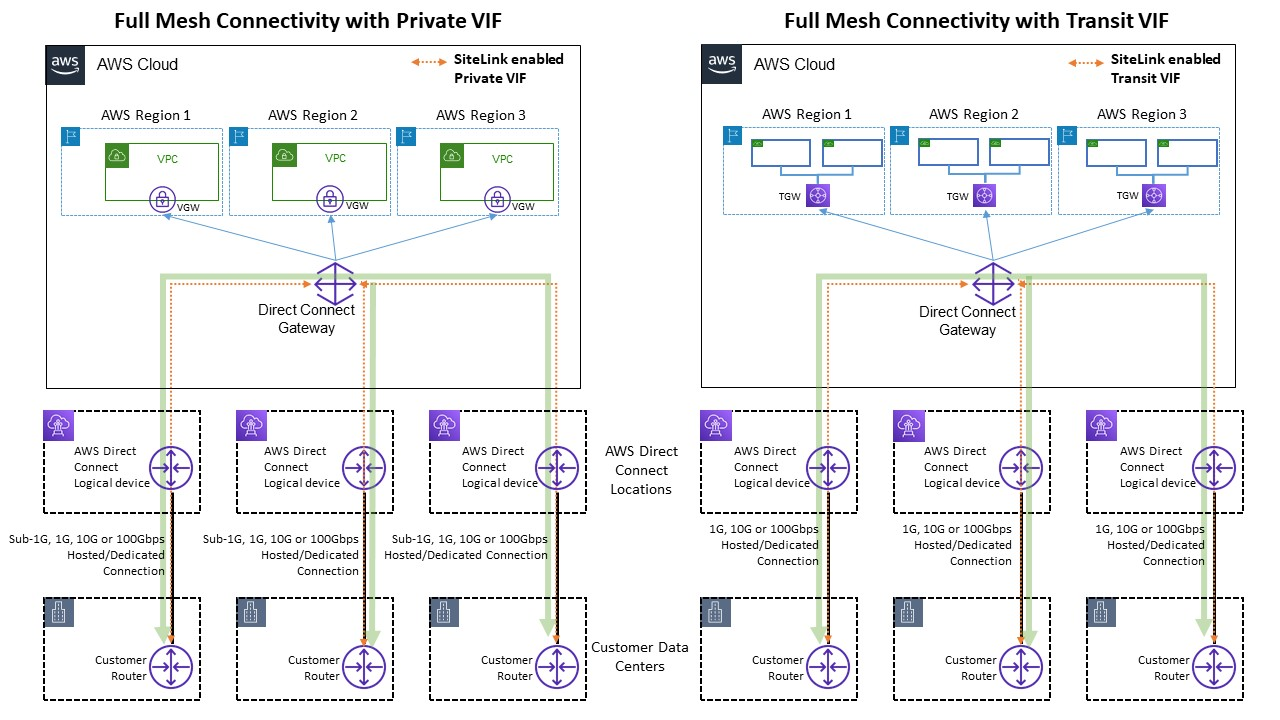
While VPN over internet is a great option to get started, internet connectivity may not be reliable for production traffic. Because of this unreliability, many customers choose AWS Direct Connect . AWS Direct Connect is a networking service that provides an alternative to using the internet to connect to AWS. Using AWS Direct Connect, data that would have previously been transported over the internet is delivered through a private network connection between your facilities and AWS. In many circumstances, private network connections can reduce costs, increase bandwidth, and provide a more consistent network experience than internet-based connections. There are several ways to use AWS Direct Connect to connect to VPCs:

Ways to connect your on-premises data centers using AWS Direct Connect
The “transit VIF to Direct Connect gateway” option might seem to be the best option because it lets you consolidate all your on-premises connectivity for a given AWS Region at a single point (Transit Gateway) using a single BGP session per Direct Connect connection; however, some of the limits and considerations around this option might lead you to use both private and transit VIFs in conjuction for your Landing Zone connectivity requirements.
The following figure illustrates a sample setup where Transit VIF is used as a default method for connecting to VPCs and a private VIF is used for an edge use case where exceptionally large amounts of data must be transferred from an on-premises Data Center to the media VPC. Private VIF is used to avoid Transit Gateway data processing charges. As a best practice, you should have at least two connections at two different Direct Connect locations for maximum redundancy —a total of four connections. You create one VIF per connection for a total of four private VIFs and four transit VIFs. You can also create a VPN as backup connectivity to AWS Direct Connect connections.
With the “Create GRE tunnels to Transit Gateway over a transit VIF” option, you get the capability to natively connect your SD-WAN infrastructure with AWS. It eliminates the need to setup IPsec VPNs between SD-WAN network virtual appliances and Transit Gateway.

Sample reference architecture for hybrid connectivity
Use the Network Services account for creating Direct Connect resources enabling demarcation of network administrative boundaries. The Direct Connect connections, Direct Connect gateways, and Transit Gateways can all reside in a Network Services account. To share the AWS Direct Connect connectivity with your Landing Zone, simply share the Transit Gateway through AWS RAM with other accounts.
Customers can use MAC Security Standard (MACsec) encryption (IEEE 802.1AE) with their Direct Connect connections for 10 Gbps and 100 Gbps dedicated connections at select locations . With this capability, customers can secure their data on the layer 2 level, and Direct Connect delivers point-to-point encryption. To enable the Direct Connect MACsec feature, ensure that the MACsec pre-requisites are met. Because MACsec protects links on a hop-by-hop basis, your device must have a direct layer 2 adjacency with our Direct Connect device. Your last-mile provider can help you verify that your connection will work with MACsec. For more information refer to Adding MACsec security to AWS Direct Connect connections .
With AWS Direct Connect, customers can achieve highly resilient connectivity into their Amazon VPCs and AWS resources from their on-premises networks. It is best practice that customers connect from multiple data centers to eliminate any single point physical location failures. It is also recommended that, depending on the type of workloads, customers utilize more than one Direct Connect connection for redundancy.
AWS also offers the AWS Direct Connect Resiliency Toolkit, which provides customers with a connection wizard with multiple redundancy models; to help them determine which model works best for their service level agreement (SLA) requirements and design their hybrid connectivity using Direct Connect connections accordingly. For more information, refer to AWS Direct Connect Resiliency Recommendations .
Previously, configuring site-to-site links for your on-premises networks was only possible by using direct circuit buildout through dark fiber or other technologies, IPSEC VPNs, or by using third-party circuit providers with technologies such as MPLS, MetroEthernet, or legacy T1 circuits. With the advent of SiteLink, customers can now enable direct site-to-site connectivity for their on-premises location that terminate at an AWS Direct Connect location. Use your Direct Connect circuit to provide site-to-site connectivity without having to route traffic through your VPCs, bypassing the AWS region completely.
Now, you can create global, reliable, and pay-as-you-go connections between the offices and data centers in your global network by sending data over the fastest path between AWS Direct Connect locations.

Sample reference architecture for AWS Direct Connect SiteLink
When using SiteLink, you first connect your on-premises networks to AWS at any of over 100 AWS Direct Connect locations worldwide. Then, you create virtual interfaces (VIFs) on those connections and enable SiteLink. Once all VIFs are attached to the same AWS Direct Connect gateway (DXGW), you can start sending data between them. Your data follows the shortest path between AWS Direct Connect locations to its destination, using the fast, secure, and reliable AWS global network. You don’t need to have any resources in any AWS Region to use SiteLink.
With SiteLink, the DXGW learns IPv4/IPv6 prefixes from your routers over SiteLink enabled VIFs, runs BGP best path algorithm, updates attributes such as NextHop and AS_Path, and re-advertises these BGP prefixes to the rest of your SiteLink-enabled VIFs associated with that DXGW. If you disable SiteLink on a VIF, the DXGW will not advertise the learned on-premises prefixes over this VIF to the other SiteLink-enabled VIFs. The on-premises prefixes from a SiteLink disabled VIF is only advertised to the DXGW Gateway associations, such as AWS Virtual Private Gateways (VGWs) or Transit Gateway (TGW) instances associated with the DXGW.

Sitelink allows traffic flows example
SiteLink allows customers to use the AWS global network to function as a primary or secondary/backup connection between their remote locations, with high bandwidth and low latency, with dynamic routing to control which locations can communicate with each other and with your AWS regional resources.